
Dyer Observatory completed another round of summer camps this past July. The two week-long day camps, one for rising 5th and 6th graders and a second for rising 7th and 8th graders, immersed campers in a multitude of hands-on projects and demonstrations, introduced them to world-class scientists, and even took them on a day trip to the U.S. Space & Rocket Center in Huntsville, Alabama.
Campers started off the week with a fun team-building project – developing a lander made from household materials to protect an egg astronaut, or eggonaut, dropped from a shell-shattering height. Teams used balloons and homemade parachutes to produce modules reminiscent of what NASA’s billion-dollar rovers used to survive their trips to the Martian surface. To up the stakes, the landers weren’t dropped from the roof – they were released from a drone hovering about 100 feet up. In most cases, the teamwork paid off, and the eggonauts survived the fall. Sometimes things didn’t work out quite as planned, and eggonauts had more of a plummet than graceful landing. Sometimes Mother Nature also had other plans with well-timed gusts of wind that pushed some eggonauts into trees. In any case, every eggonaut’s journey was a thrill for all.
Dyer’s camps also incorporated guest speakers whenever possible, and this year our 7th-8th grade camp had two. Dr. David Weintraub, Vanderbilt professor emeritus of astronomy, led campers through a recreation of William Herschel’s famous 1800 experiment in which he discovered a type of invisible light we now know as infrared. Dr. Weintraub then took campers on a journey discussing other types of invisible light, how we know they exist, and how astronomers are able to learn about the universe with all of these parts of the electromagnetic spectrum. Dyer Observatory’s director Dr. Billy Teets (once a PhD student of Weintraub) took the concepts further to demonstrate what information is encoded in light and how astronomers extract it. A highlight was the use of a thermal (infrared) camera to allow campers to see what they and other things, even animals, look like in this invisible form of light.
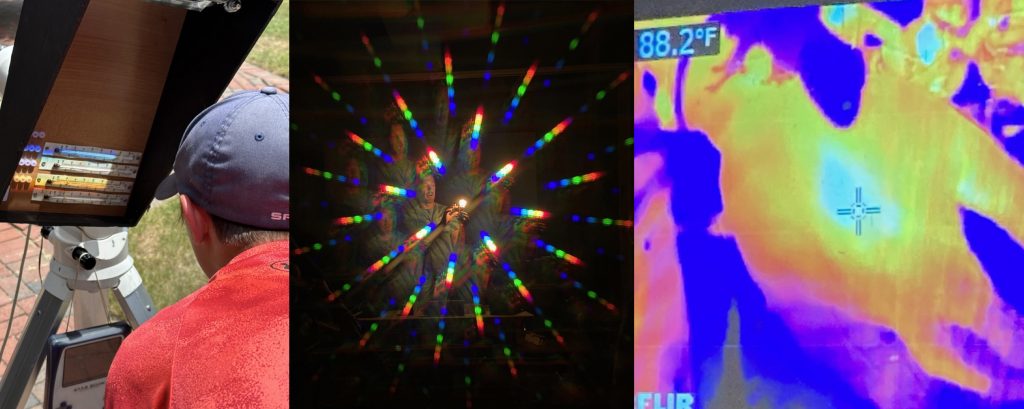

Later in the week, Vanderbilt professor of mathematics Dr. Marcelo Disconzi visited and discussed with the campers the concept of the expanding universe including using a combination of balloons, stickers, and markers to simulate our universe’s evolution. Before leaving, Disconzi also dispersed to campers their own copy of the book Who Me? Im a Mathematician Now, one of (currently) nine books of a series in which a Vanderbilt scientist tells their own story of what it was like when they were in grade school and how they got to where they are today. The series, the brainchild of David Weintraub, hopes to inspire children to realize that scientists are just regular people and that they, too, can become whatever they want if they try. Disconzi is the subject of this latest volume.
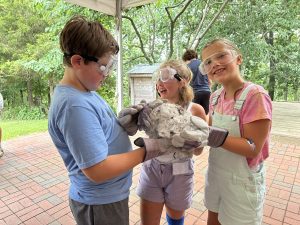
Any sort of project that deals with some type of extreme is always an attention grabber. A hands-on (well, gloves-on) activity done each camp allows campers to create rather realistic models of comets using materials found in real comets including water, ice, dust, rock, and a heaping portion of dry ice. When the dry ice is added, the mixture of materials immediately comes to life. Fog billows from the mixing bags, the water churns and bubbles, and the rapidly freezing concoction pops and seethes. After a minute or so, campers finally get a first glimpse of their comet nucleus. Even if some groups achieve a bunch of smaller nuclei instead of one massive object, they have still produced a marvelous example of a rubble-pile comet.
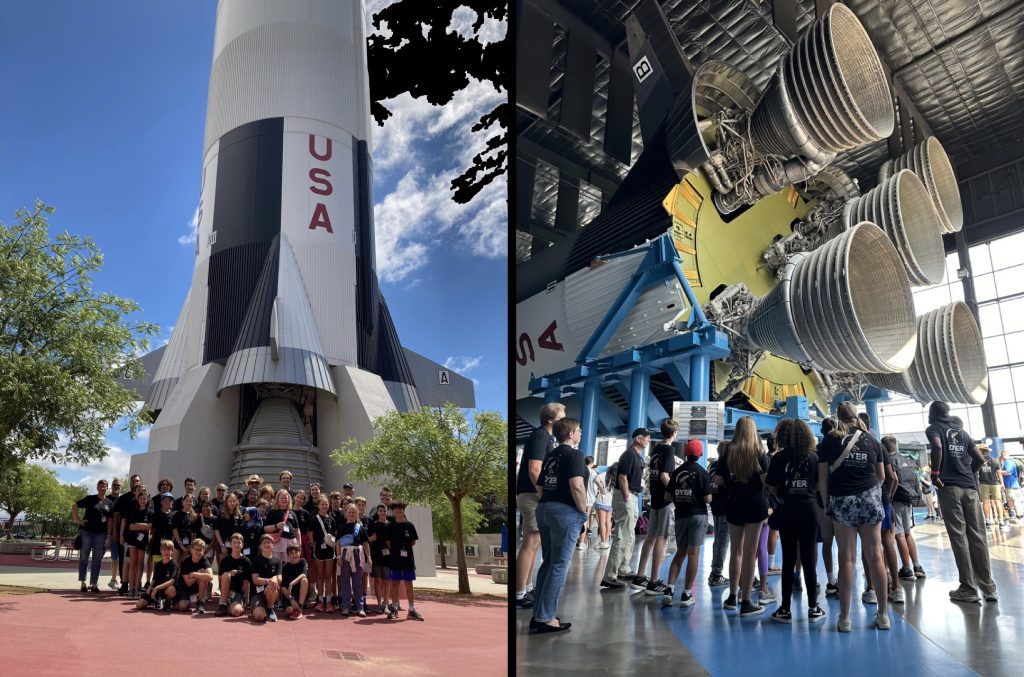
One of the highlights of the week was a trip to the U.S. Space & Rocket Center in Huntsville, Alabama. Campers and staff toured the facility’s Davidson Center, which houses one of only three remaining Saturn V rockets, the 363-foot-tall vehicle that first took humans to the Moon in 1969. As they toured, campers even had the opportunity to talk with docents who had been involved in the Apollo program. Later, a visit to the Intuitive Planetarium took campers on an immersive tour of our solar system, visiting each of the planets as well as our Moon before journeying out to the farthest extents of our visible universe. Of course, the USSRC’s rides were also a big hit.
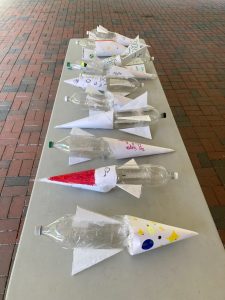

After spending a day exploring and learning about actual rockets, campers took their newfound knowledge to the drawing board to construct their own rockets; however, instead of using combustible fuel, their rockets utilized water and compressed air. Teams of campers used two-liter bottles and designed their own fins and nose cones to come up with a design that would achieve the greatest height. Rockets were launched in front of the observatory while a counselor used an inclinometer (and a little trigonometry) to determine the final altitudes of the rockets. Some reached altitudes of well over 100 feet. Some, however, didn’t get quite as far, and some even found final resting places in the surrounding tree canopy. A good wind storm will finally get them to the ground.
This year, campers focused a significant amount of their time on a larger project – construction of functioning 1/15th-scale models of the Hubble Space Telescope. The models, which were developed from scratch by Dyer staff, replicated many of the functions of what is arguably the most famous telescope ever built. After first learning of the basics of how telescopes work, campers were then introduced to electronic components such as resistors, LEDs, servos, and a type of microcontroller known as an Arduino Uno, all of which were used to build simple projects that also introduced a bit of programming. A goal was not only to demonstrate the ease at which simple electronic projects can be completed but also to inspire the campers’ imaginations about what they could do on their own outside of camp. With so many tutorials and other resources available online and the minimal costs of electronic components (e.g., Arduino Uno boards can be purchased for $10-$15), the sky is the limit in what can be created. In fact, several of Dyer Observatory’s exhibits and telescopes, including the historic Seyfert Telescope, run on Arduino microcontrollers.

The camp Hubble Space Telescope models incorporated a number of components that campers assembled including a wooden dowel chassis complete with 3D-printed braces, a 6″ parabolic mirror to represent Hubble’s 2.4-meter mirror, a WiFi camera, weighted motor (the reaction wheel), transceiver (wireless communication), solar panels, and circuit board controlled by an Arduino Uno. Camp teachers led the campers as one large group through each of the assembly stages, discussing how their components were similar/different to those on the actual Hubble Space Telescope. When all components were assembled, the telescopes were suspended around the library. Camp groups then remotely connected to their models via the transceivers, allowing them to activate cameras and reaction wheels. When the reaction wheels spun one way, the telescope slowly turned the opposite direction, just as the real Hubble would.
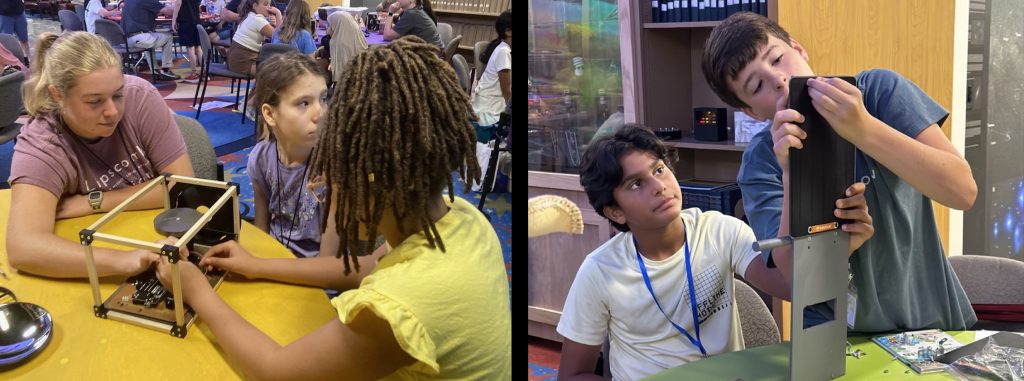

With each week of camp packed to the brim with activities, the time flies by. Each Friday afternoon, parents and family members were invited to Dyer to partake in some of the final demonstrations and to see what their campers had worked on during the week, including a demonstration of how their Hubble Telescope models worked. But what better way to bring the camps to a close than with ice cream, especially homemade using liquid nitrogen that boils at a chilly -321°F! As counselors prepared the frosty treat, camp teachers demonstrated some of the other fun ways in which liquid nitrogen could be used including freezing and shattering a carnation, deflating a balloon without popping it, shattering a banana, and even demonstrating superconductivity by levitating a magnet above a superconducting disk. These demos, observed with a sweet treat in hand, made for a memorable end to the week.
Dyer Observatory will be holding camps again next summer for rising 5th-8th graders. Information will be posted to our camps page at the start of 2025. Stay tuned!